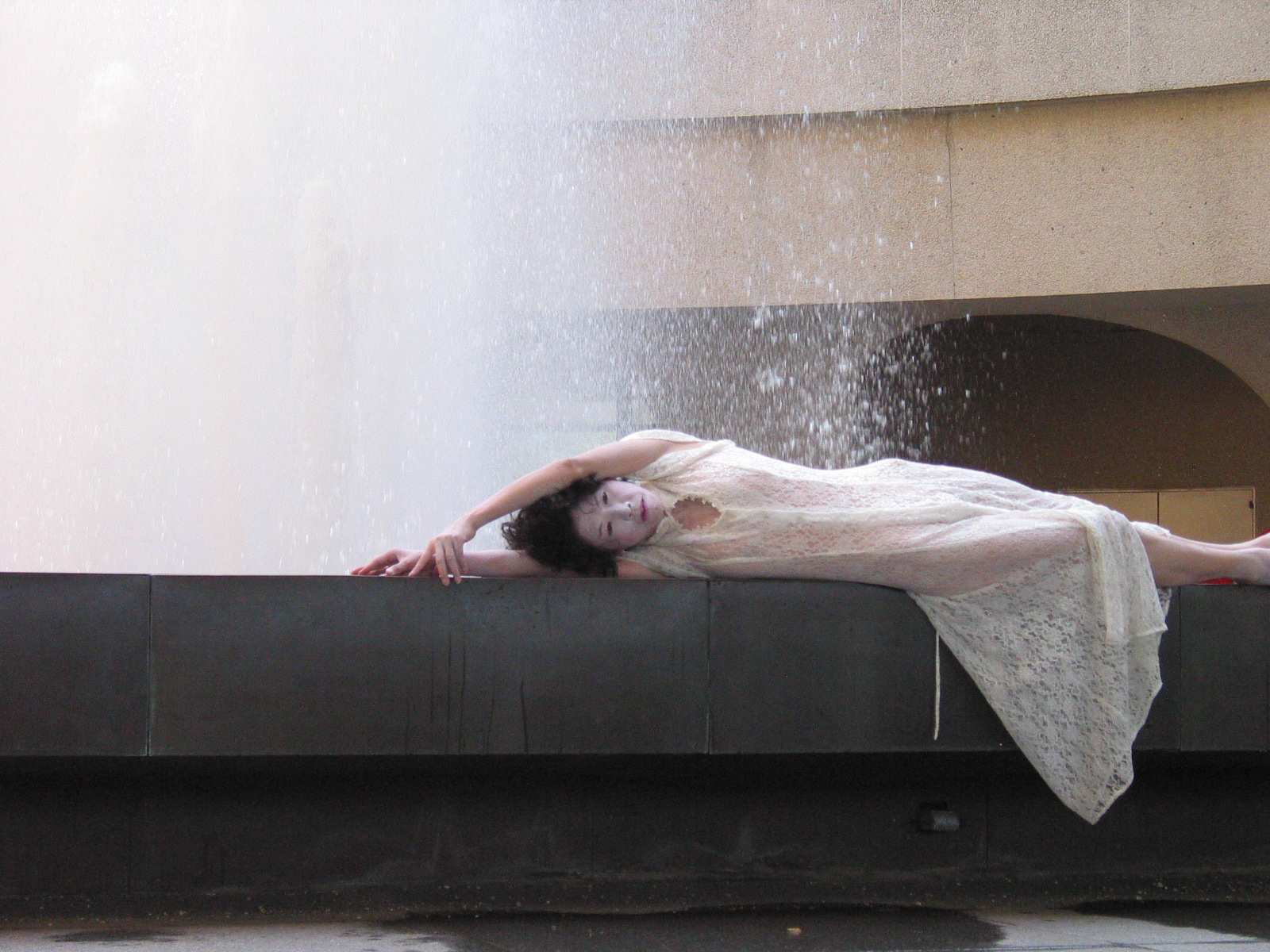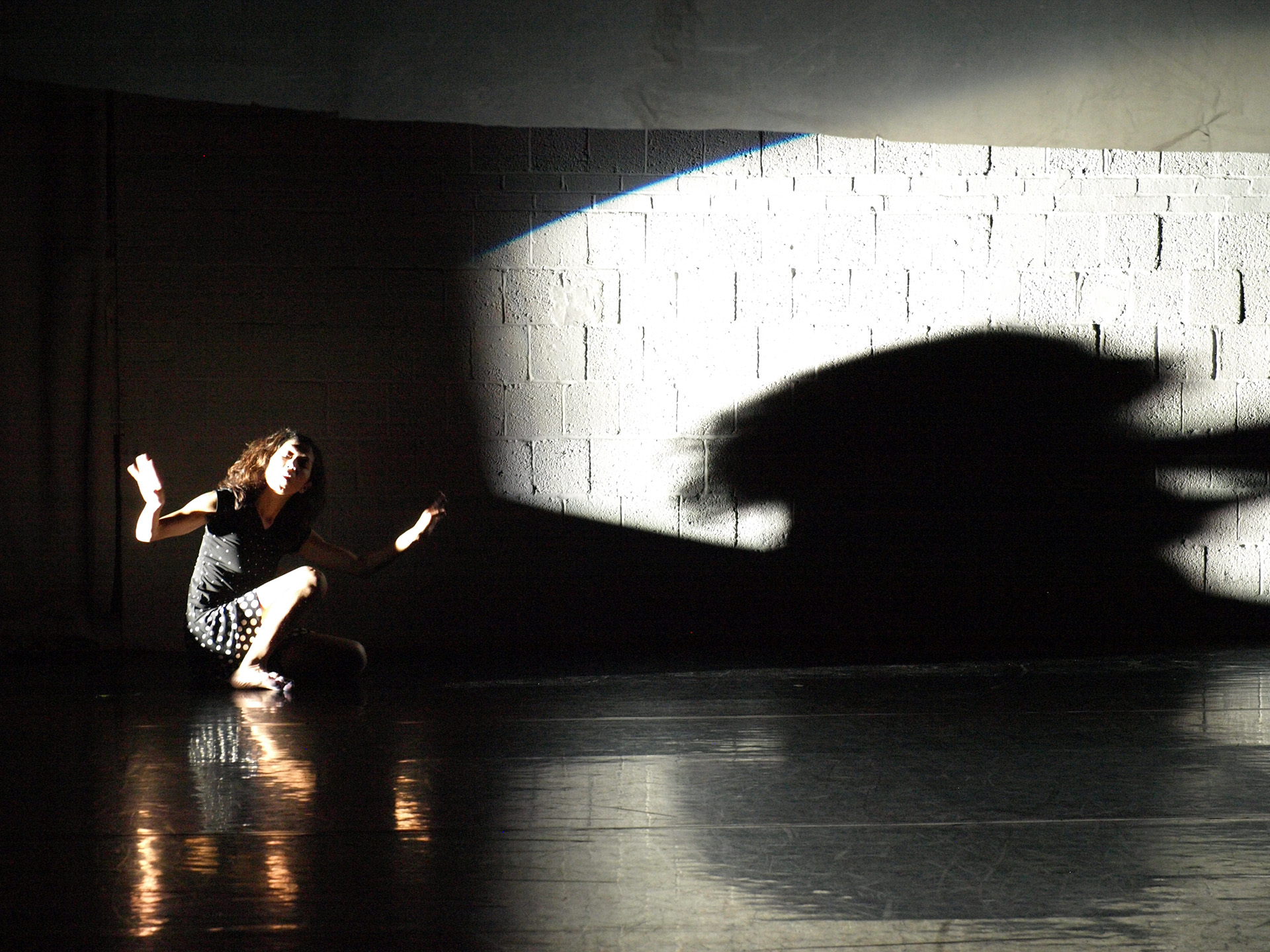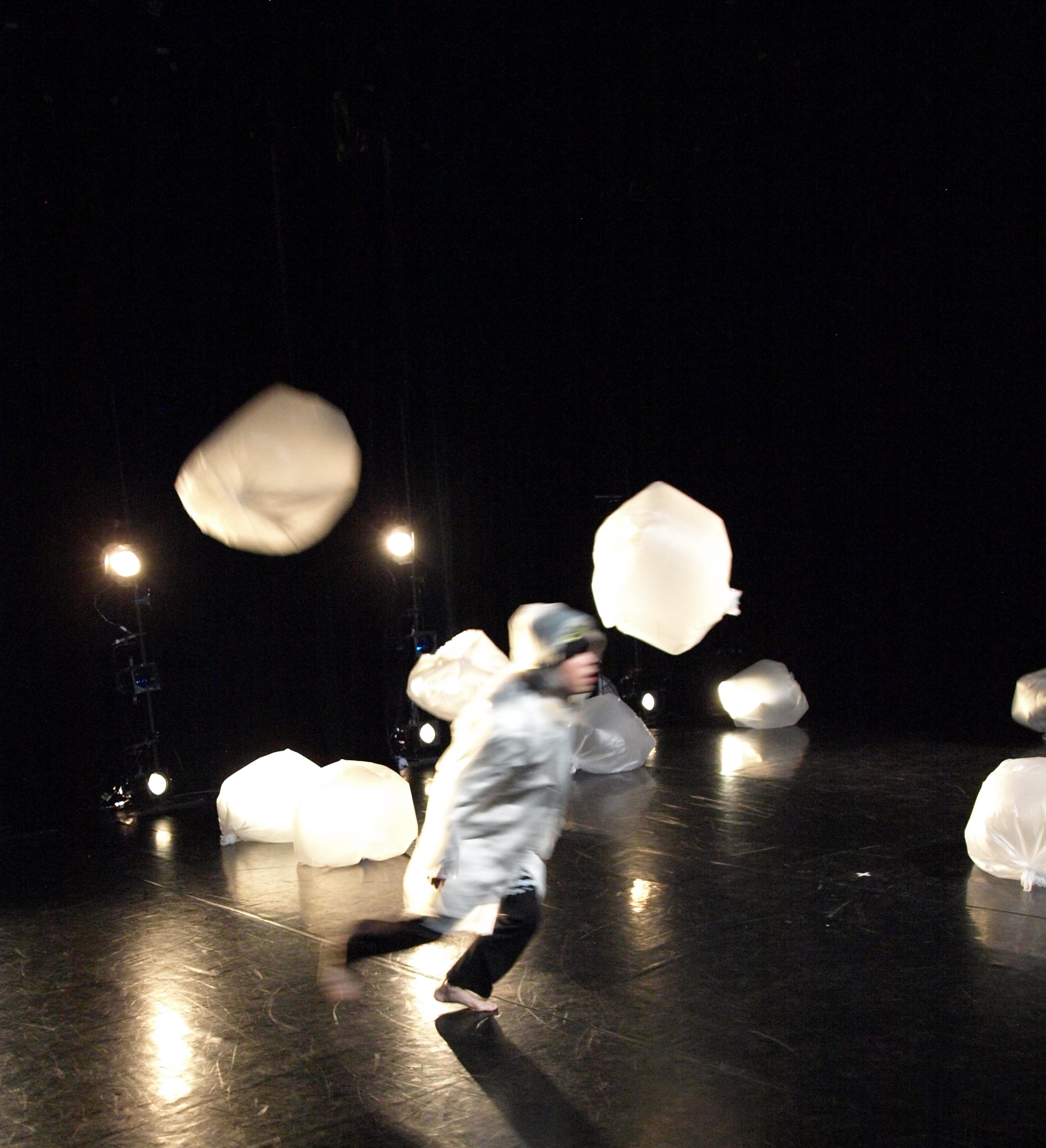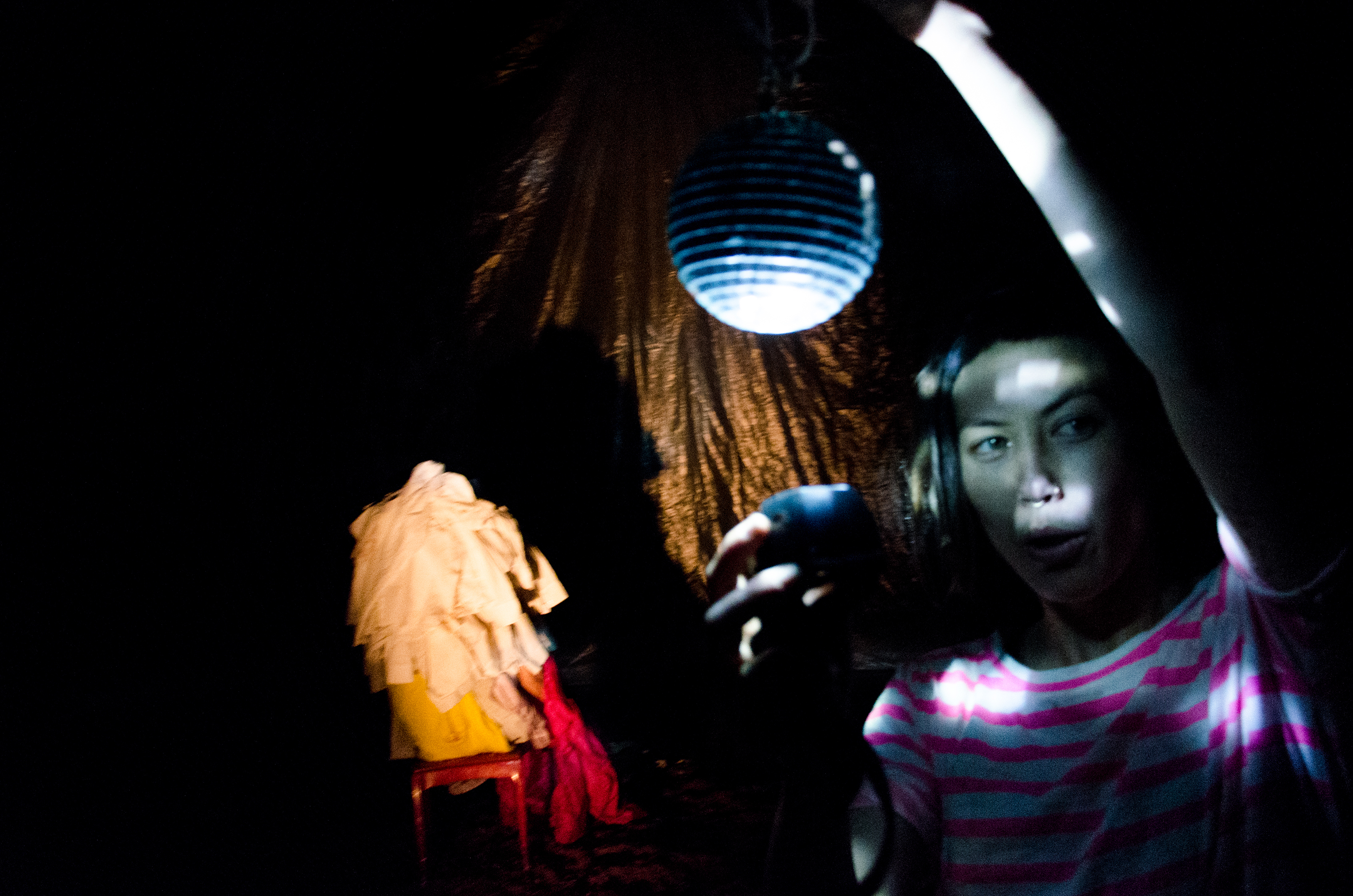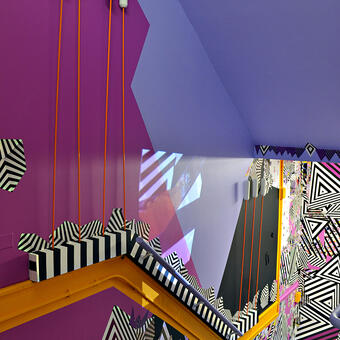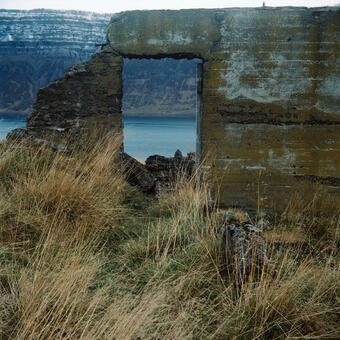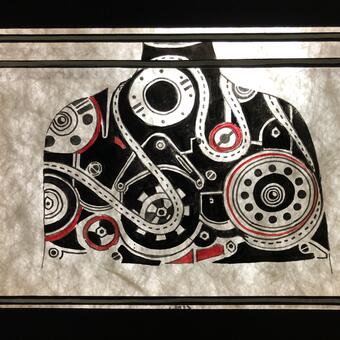About A

I was raised on the post WW2 western Pacific island of Guam from 1952 to 1963. It was a paradise of extremes, from the glorious treasures of the ocean, to giant coconut crabs and the lavish fiestas where all races were welcome. In contrast, hidden bombs and hand grenades were still being tripped over and killing people years after the war. However, it was the typhoons that devastated Guam five times that caused us to return to America. Following three transformative years in Long Beach… more
Jump to a project:
BODY AND ENVIRONMENT - Site Study
Places outside of the theatre space are unregulated. I could disappear or appear in the landscape anytime. How can I exist in a place without dominating it or isolating myself from it? Can my body be a part of the landscape? Can it become an environment within the environment? How can I form a relationship with the place? I plan to continue and deeper this study in the near future.
******************************************************************************************
WHEN THE WIND CROSSED MY BODY CRIED LIKE AN OCTOPUS (2010)
Site #1 - Bridge that separates old town from new town
Site #2 - Under the small bridge over a river in the center of the city
Site #3 - Theatre Jo at CESTA (Cultural Exchange Station in Tabor), Tabor, Czech Republic
This is a three-part performance project, examining how the sensation of movements in the body can be transmitted from one location to another. First two were done in specific sites near CESTA (Cultural Exchange Station) in Tabor where I was conducting an artist residency. First site was under the bridge which severs the old town and the new town. The second site was in the river in the center of the old town. The last part was presented in the theatre inside CESTA, drawing the traces left in my body through the previous two studies. I continued to carry the magic mirrors from "Face of Another (2010)" and "Modernity Stripped Bare (2011)". My deep curiosity about 'self' was starting to emerge through this project.
GYROSCOPE PROJECT (2003)
Site - Exterior of Hirschhorn Museum of Smithsonian Institute, DC
A site-specific performance in conjunction with the museum’s exhibit, “Gyroscope." This solo section was incorporated in an ensemble piece with ten performers and one live musician who worked with the exhibits inside and outside of the museum. The wind, surrounding audience, the sound of the fountain, and splashing water, all gave me great stimuli to work with. I clearly remember the moment I laid my whole body on the ledge of the fountain which was about six inches wide.
SOLO DANCE (2008)
Site - A selected landscape in Hakushu, Japan
I returned to this place where I started my artistic journey in 1993. I wanted to see how my body and mind remembered this place. Each of the invited dancers selected a specific site for her work. I chose this site because I was drawn to the beautiful backdrop of nature which contrasted with the dry field in front that had nothing growing at the time. The performance lasted 70 minutes. This piece was performed as a part of Dance Hakushu Festival, a multidisciplinary performance festival that has brought all kinds of artists from far away and close since 1988.
A ROSE IN THE WILD (2007)
Site - Exterior of Martin Luther King Library
This performance happened twice on the same day - 1pm and 5pm. The passing time
THE HOLE (2002)
Site - Interior of the building of Center for the Arts @ Towson University
I fell in love with a student's art exhibit called "Biodegradable" that was installed n the jI fell in love with a student's art installation called "Biodegradable" that was built in the juncture of the staircases extending to the basement. I wondered what the journey would be like to descend into this long tunnel made of plastic bags and trash. Gabriel Walked accompanied me on this journey with his Shakuhachi.
******************************************************************************************
WHEN THE WIND CROSSED MY BODY CRIED LIKE AN OCTOPUS (2010)
Site #1 - Bridge that separates old town from new town
Site #2 - Under the small bridge over a river in the center of the city
Site #3 - Theatre Jo at CESTA (Cultural Exchange Station in Tabor), Tabor, Czech Republic
This is a three-part performance project, examining how the sensation of movements in the body can be transmitted from one location to another. First two were done in specific sites near CESTA (Cultural Exchange Station) in Tabor where I was conducting an artist residency. First site was under the bridge which severs the old town and the new town. The second site was in the river in the center of the old town. The last part was presented in the theatre inside CESTA, drawing the traces left in my body through the previous two studies. I continued to carry the magic mirrors from "Face of Another (2010)" and "Modernity Stripped Bare (2011)". My deep curiosity about 'self' was starting to emerge through this project.
GYROSCOPE PROJECT (2003)
Site - Exterior of Hirschhorn Museum of Smithsonian Institute, DC
A site-specific performance in conjunction with the museum’s exhibit, “Gyroscope." This solo section was incorporated in an ensemble piece with ten performers and one live musician who worked with the exhibits inside and outside of the museum. The wind, surrounding audience, the sound of the fountain, and splashing water, all gave me great stimuli to work with. I clearly remember the moment I laid my whole body on the ledge of the fountain which was about six inches wide.
SOLO DANCE (2008)
Site - A selected landscape in Hakushu, Japan
I returned to this place where I started my artistic journey in 1993. I wanted to see how my body and mind remembered this place. Each of the invited dancers selected a specific site for her work. I chose this site because I was drawn to the beautiful backdrop of nature which contrasted with the dry field in front that had nothing growing at the time. The performance lasted 70 minutes. This piece was performed as a part of Dance Hakushu Festival, a multidisciplinary performance festival that has brought all kinds of artists from far away and close since 1988.
A ROSE IN THE WILD (2007)
Site - Exterior of Martin Luther King Library
This performance happened twice on the same day - 1pm and 5pm. The passing time
THE HOLE (2002)
Site - Interior of the building of Center for the Arts @ Towson University
I fell in love with a student's art exhibit called "Biodegradable" that was installed n the jI fell in love with a student's art installation called "Biodegradable" that was built in the juncture of the staircases extending to the basement. I wondered what the journey would be like to descend into this long tunnel made of plastic bags and trash. Gabriel Walked accompanied me on this journey with his Shakuhachi.
-
The Hole (2002) - Interior of the Center for the Arts building @ Towson University, MDIn this study, I'm exploring the interior of the center for the arts building at Towson University. with Gabriel Walker, the musician, and the installation called 'Biodegradable' on the site.
-
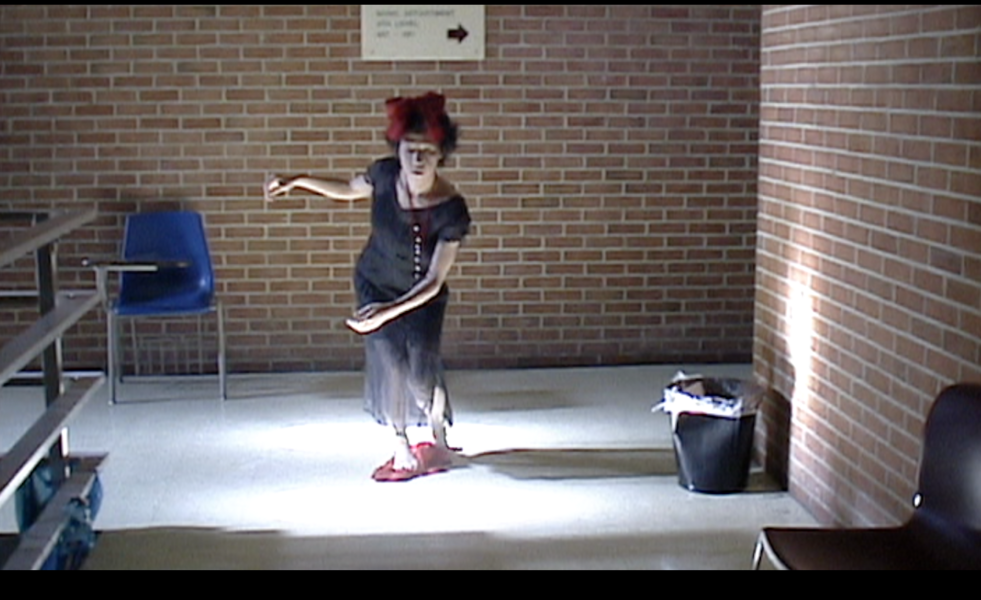 The Hole (2002) @ Center for the Arts building, Towson University, MDI fell in love with a student's art installation called "Biodegradable" that was built in the juncture of the staircases extending from the fourth floor to the basement. I wondered what the journey would be like to descend into this long tunnel made of plastic bags and trash. Gabriel Walked accompanied me on this journey with his Shakuhachi.
The Hole (2002) @ Center for the Arts building, Towson University, MDI fell in love with a student's art installation called "Biodegradable" that was built in the juncture of the staircases extending from the fourth floor to the basement. I wondered what the journey would be like to descend into this long tunnel made of plastic bags and trash. Gabriel Walked accompanied me on this journey with his Shakuhachi. -
A Rose in the Wild (2007)- Exterior of Martin Luther King Library @ The 13th annual International Improvisation Festival, Washington, D.C."Soloist Naoko Maeshiba dealt masterfully with some challenging interlopers.Also performing outside the library, Maeshiba capitalized on the proximity of her audience with minute wiggles of a single finger or toe. These movements would have been almost undetectable in a traditional theater setting." – The Washington Post
-
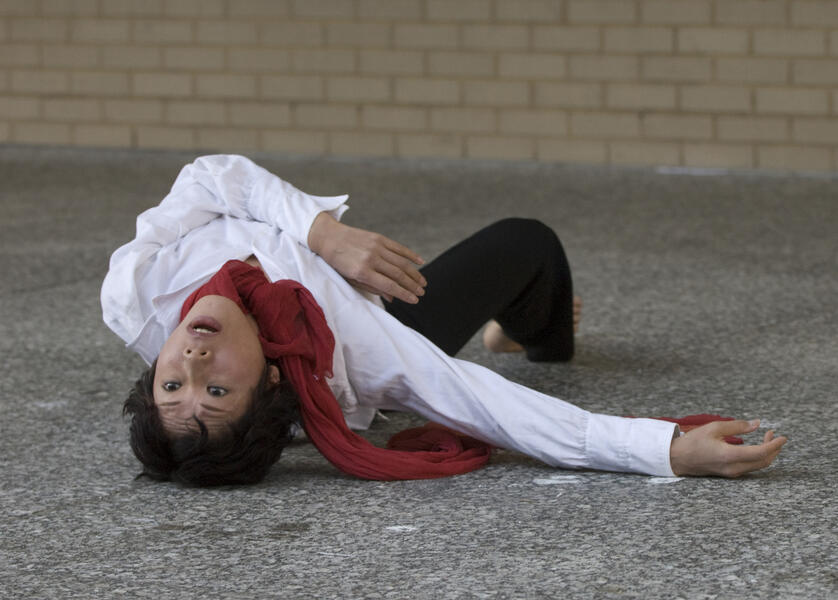 A Rose in the Wild (2007) @ Exterior of Martin Luther King Library in Washington, D.C."…Maeshiba excelled at adapting to her environment." – The Washington Post
A Rose in the Wild (2007) @ Exterior of Martin Luther King Library in Washington, D.C."…Maeshiba excelled at adapting to her environment." – The Washington Post -
Solo Dance (2008)- A selected site in the village of Hakushu @ Dance Hakushu Festival, Solo Dance series, Hakushu, JapanI returned to this place where my journey as a dancer started in 1993. I wanted to see how my body and mind remembered this place. In this series called 'Solo Dance', each of the invited dancers selected a specific site for her dance. I was drawn to the landscape of this site which made a contrast with the dry flat field which had nothing growing at the time. This 70-minute piece was performed as a part of Dance Hakushu Festival, an international performing art festival with 20 years of history.
-
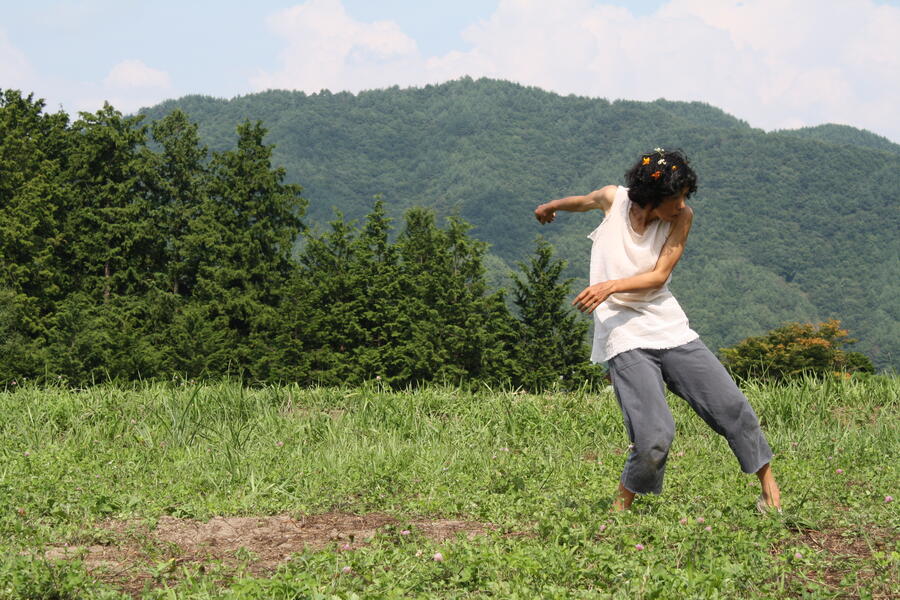 Solo Dance (2008) @ Dance Hakushu Festival, Hakushu, JapanAfter each dance was performed, a talk session was held with the modern philosophers and the dance critics. My respondent was Kuniichi Uno, whose specialty was Bodymedia theory. “Uno: ...Today, I was wondering how a dancer and the audience live the time that continues to flow without any break. I was watching your dance through this lens perhaps because it might be connected to I’ve been thinking lately. But I think it is largely because the way you danced today. It evoked symbolism. I was thinking, if you melt into that hole, what would happen to her? Death? I was shocked. I understand what you meant by ‘wearing the dirt’. It felt to me that you were going through the process of ‘wearing time’, weaving the time of this place continuously. It looked like it was going to end, but it didn’t end, which is in line with what you said that the piece is not about meaning. Maeshiba: When I direct an existing scripted play, I need to be meticulously searching for a reason. When I dance, I don’t want to have a reason constructed by my mind. For this performance, I was trying to do something that has no meaning but expands audience imagination.” – ‘Let’s talk about dance’ – a post performance talk in Dance Hakushu 2008
Solo Dance (2008) @ Dance Hakushu Festival, Hakushu, JapanAfter each dance was performed, a talk session was held with the modern philosophers and the dance critics. My respondent was Kuniichi Uno, whose specialty was Bodymedia theory. “Uno: ...Today, I was wondering how a dancer and the audience live the time that continues to flow without any break. I was watching your dance through this lens perhaps because it might be connected to I’ve been thinking lately. But I think it is largely because the way you danced today. It evoked symbolism. I was thinking, if you melt into that hole, what would happen to her? Death? I was shocked. I understand what you meant by ‘wearing the dirt’. It felt to me that you were going through the process of ‘wearing time’, weaving the time of this place continuously. It looked like it was going to end, but it didn’t end, which is in line with what you said that the piece is not about meaning. Maeshiba: When I direct an existing scripted play, I need to be meticulously searching for a reason. When I dance, I don’t want to have a reason constructed by my mind. For this performance, I was trying to do something that has no meaning but expands audience imagination.” – ‘Let’s talk about dance’ – a post performance talk in Dance Hakushu 2008 -
Gyroscope Project (2004)- Exterior of the museum @ Hirshhorn Museum and Sculpture Garden, Washington, D.C.A site-specific performance in conjunction with the museum’s exhibit, “Gyroscope." This solo section was incorporated in an ensemble piece with ten performers and one live musician who interacted with the exhibits inside and outside of the museum.
-
 Gyroscope Project (2004) @ Hirshhorn Museum and Sculpture Garden, Washington, D.C.The wind, surrounding audience, the sound of the fountain, and splashing water, all gave me great stimuli to work with. I clearly remember the moment I laid my whole body on the ledge of the fountain which was about six inches wide. When I arrived at the destination, the whole surface of my back merged with the rising and falling water of the fountain.
Gyroscope Project (2004) @ Hirshhorn Museum and Sculpture Garden, Washington, D.C.The wind, surrounding audience, the sound of the fountain, and splashing water, all gave me great stimuli to work with. I clearly remember the moment I laid my whole body on the ledge of the fountain which was about six inches wide. When I arrived at the destination, the whole surface of my back merged with the rising and falling water of the fountain. -
When the wind crossed my body cried like an octopus (2010) - Under the bridge that severs old town and new town and in the river @ CESTA, Tabor, Czech RepublicThis is a three-part performance project, examining how the sensation of movements in the body can be transmitted from one location to another. First two were done in specific sites near CESTA (Cultural Exchange Station) in Tabor where I was conducting an artist residency. First site was under the bridge which severs the old town and the new town. The second site was in the river in the center of the old town. The last part was presented in the theatre inside CESTA, drawing the traces left in my body through the previous two studies.
-
 When the wind crossed my body cried like an octopus (2010) @ CESTA, Tabor, Czech Republic"NM: Tabor. This was three hours from Prague. I was given the time and space to really face myself by myself, and the place was so supportive. I took walks every morning. I just wanted to be around the city. I did two dance studies there. One study was in the river. It was a strong current. I was descending. I was sitting on a chair. There was a pool underneath. I was coming down to a ledge above the pool. I knew the pool was really shallow. There was no danger. I was really stuck on this ledge. I had a hard time going down there. I didn’t want to show fear. I was kind of dancing, thinking, ‘I have to go I have to go,’ and it was really cold, and then, finally, I decided, I’m going to go, one two three. And then, one two three, and I dived in. I was floating. Then I was sinking. I had to swim. And I was cold, so I had to get out of the water. That experience was so strong." - DC Theatre Scene
When the wind crossed my body cried like an octopus (2010) @ CESTA, Tabor, Czech Republic"NM: Tabor. This was three hours from Prague. I was given the time and space to really face myself by myself, and the place was so supportive. I took walks every morning. I just wanted to be around the city. I did two dance studies there. One study was in the river. It was a strong current. I was descending. I was sitting on a chair. There was a pool underneath. I was coming down to a ledge above the pool. I knew the pool was really shallow. There was no danger. I was really stuck on this ledge. I had a hard time going down there. I didn’t want to show fear. I was kind of dancing, thinking, ‘I have to go I have to go,’ and it was really cold, and then, finally, I decided, I’m going to go, one two three. And then, one two three, and I dived in. I was floating. Then I was sinking. I had to swim. And I was cold, so I had to get out of the water. That experience was so strong." - DC Theatre Scene
Contemplating on FUKUSHIMA, TRASH, BODY - Dream Island (2015)
These two pieces used the same material, a huge plastic sheet that stood like a wall. I was obsessed by its texture, history and association, and translucent nature to be able to alter the visual perception. The wall came down and disappeared from the stage with no trace in both pieces. Fukushima, nuclear, and trash had been on my mind since 3.11 happened in Japan four years ago.
********************************************************************************************
DREAM ISLAND (2015) - full-length
Concept, choreography, direction, environment/object design, and performance
In March 2011, I heard a disturbing news that the radioactive material started leaking into the ocean near Fukushima nuclear plant. I had a visceral response to this - all the cells in my body cried out as if my own body got violated. My fond memories about water and ocean started coming back. A great sense of urgency hit me. This urge became the driving force of "Dream Island".
The piece through a three-year process from the conception to the realization. Dramaturgy was built upon the place in Japan called Yumenoshima (Dream Island), which was a Japanese theme park built on a buried landfill. Movement, text, and sound were generated, constructed, and polished through the nine-month rehearsal process. Piece was 85 minutes long consisting of 14 vignettes.
The stage was set up as a thrust configuration with a square on the floor made by a danger zone tape. Audience members were invited to sit around it.
Material: large plastic sheets, dirt
Lighting Design: Rebecca Wolf
Sound Design: Khristian Weeks
Premiere - May 2015 @ Baltimore Theatre Project, Tour - June 2015 @ Joe's Movement Emporium, MD
***********************************************
WHAT WE SEE WHY WE SEE (2012) - full-length
Co-conception, choreography, direction, environment, costume/object design, and performance with Tzveta Kassavoba
Memories and perceptions are strange things. We choose to see and memorize certain things, not others. A Bulgarian choreographer, Tzveta Kassabova, and I experimented with the visual perception. Plastic sheets and bags of different sizes were used as the source material to generate the context and the movements from. Actions happened behind, under, and around them, constraining the visual information audience received.
Material - plastic sheets, plastic bags
Lighting Design: Rebecca Wolf
Music by Pauchi Sasaki
January 2012 @ Dance Place, Washington, DC
********************************************************************************************
DREAM ISLAND (2015) - full-length
Concept, choreography, direction, environment/object design, and performance
In March 2011, I heard a disturbing news that the radioactive material started leaking into the ocean near Fukushima nuclear plant. I had a visceral response to this - all the cells in my body cried out as if my own body got violated. My fond memories about water and ocean started coming back. A great sense of urgency hit me. This urge became the driving force of "Dream Island".
The piece through a three-year process from the conception to the realization. Dramaturgy was built upon the place in Japan called Yumenoshima (Dream Island), which was a Japanese theme park built on a buried landfill. Movement, text, and sound were generated, constructed, and polished through the nine-month rehearsal process. Piece was 85 minutes long consisting of 14 vignettes.
The stage was set up as a thrust configuration with a square on the floor made by a danger zone tape. Audience members were invited to sit around it.
Material: large plastic sheets, dirt
Lighting Design: Rebecca Wolf
Sound Design: Khristian Weeks
Premiere - May 2015 @ Baltimore Theatre Project, Tour - June 2015 @ Joe's Movement Emporium, MD
***********************************************
WHAT WE SEE WHY WE SEE (2012) - full-length
Co-conception, choreography, direction, environment, costume/object design, and performance with Tzveta Kassavoba
Memories and perceptions are strange things. We choose to see and memorize certain things, not others. A Bulgarian choreographer, Tzveta Kassabova, and I experimented with the visual perception. Plastic sheets and bags of different sizes were used as the source material to generate the context and the movements from. Actions happened behind, under, and around them, constraining the visual information audience received.
Material - plastic sheets, plastic bags
Lighting Design: Rebecca Wolf
Music by Pauchi Sasaki
January 2012 @ Dance Place, Washington, DC
-
 What we see why we see (2012)@Dance Place, Washington, D.C."Her performance today evoked many images for me from my memories, seeing only partly what's going on, the ocean, the dessert, old photos, seeing through a glass darkly, partly there, connections, missed connections, connections in the midst of loneliness."- Nancy Havlik
What we see why we see (2012)@Dance Place, Washington, D.C."Her performance today evoked many images for me from my memories, seeing only partly what's going on, the ocean, the dessert, old photos, seeing through a glass darkly, partly there, connections, missed connections, connections in the midst of loneliness."- Nancy Havlik -
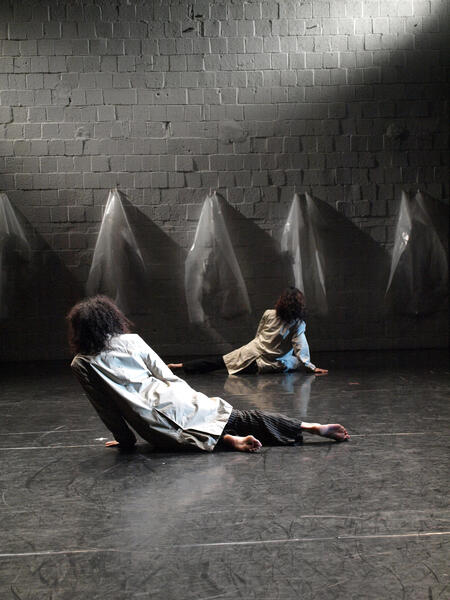 What we see why we see (2012)@Dance Place, Washington, D.C."...moments that are revelatory, but fleeting and more occasional than most people would like to admit. I like immensely that you created those moments-where we could see you and you us-clearly in a staged performance where the stage was an environment that seemed to me to represent the shadowy nature of our awareness of the objects and people in our everyday lives." - Dan Eades , "... I suspect that the performance itself is sort of a glass. With the audience seeing the performance through the glass (or lens) of their immediate awareness (or lack thereof) and minds and histories and experiences and the performers presenting themselves through their performance amidst staging that serves as almost a camouflage of their movement and their selves. But that camouflage serves to highlight moments of connection. And to remind everyone of the value of those moments, the moments, perhaps, we live for. " - Dan Eades
What we see why we see (2012)@Dance Place, Washington, D.C."...moments that are revelatory, but fleeting and more occasional than most people would like to admit. I like immensely that you created those moments-where we could see you and you us-clearly in a staged performance where the stage was an environment that seemed to me to represent the shadowy nature of our awareness of the objects and people in our everyday lives." - Dan Eades , "... I suspect that the performance itself is sort of a glass. With the audience seeing the performance through the glass (or lens) of their immediate awareness (or lack thereof) and minds and histories and experiences and the performers presenting themselves through their performance amidst staging that serves as almost a camouflage of their movement and their selves. But that camouflage serves to highlight moments of connection. And to remind everyone of the value of those moments, the moments, perhaps, we live for. " - Dan Eades -
 What we see why we see (2012)@Dance Place, Washington, D.C."Maeshiba's movements are so exact, so precise, it is difficult not to watch her closely. And her intelligence and restrained emotion radiates an awareness that seems charged with meaning." - Dan Eades
What we see why we see (2012)@Dance Place, Washington, D.C."Maeshiba's movements are so exact, so precise, it is difficult not to watch her closely. And her intelligence and restrained emotion radiates an awareness that seems charged with meaning." - Dan Eades -
What we see why we see (2012)@Dance Place, Washington, D.C. - direction/choreography/sound, costume, environment design/performance with Tzveta KassabovaMemories and perceptions are strange things. We choose to see and memorize certain things, not others. A Bulgarian choreographer, Tzveta Kassabova, and I experimented with the visual perception. Plastic sheets and bags of different sizes were used as the source material to generate the context and the movements from. Actions happened behind, under, and around them, constraining the visual information audience received. "... two artists have a lot in common. Strong, original movers who fully inhabit the space they’re in, both are foreign-born—Kassabova hails from Bulgaria, while Maeshiba is from Japan— and bring a seriousness to their movement exploration that feels, to me at least, almost un-American in its rigor...Be ready for some ambiguity: while the environment has been intentionally set by the artists, each audience member’s take on the performance will likely be a bit of an individual journey." - Washington City Paper
-
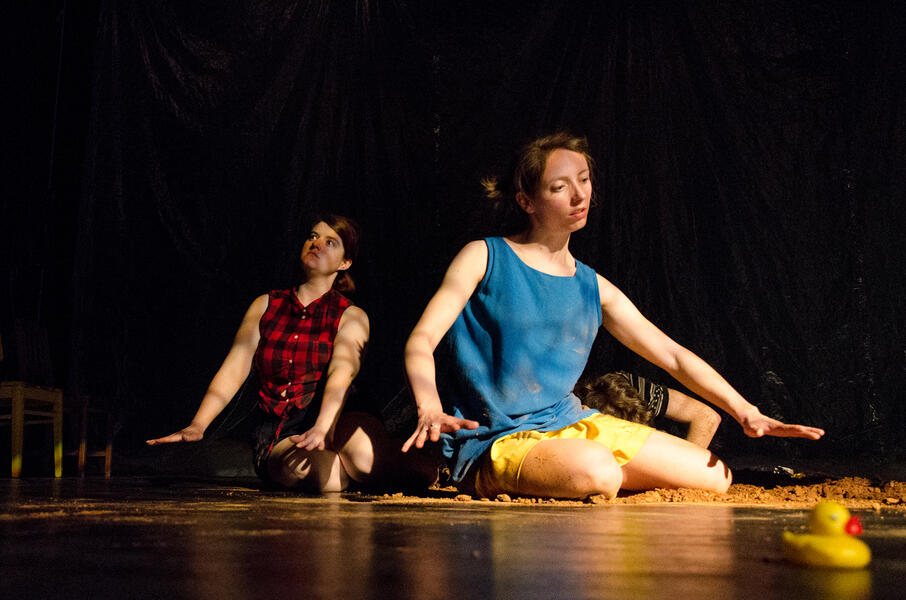 Dream Island (2015) @ Baltimore Theatre Project (MD), Joe's Movement Emporium (DC)In the second part of the performance, we asked the audience to roll their programs and see the site through the holes created by their 'telescopes'. It gave them a choice to see a specific part of the stage as well as a fragmentary view of the bodies, shifting the role of the audience from the bystanders to the participants and the witnesses of the incident. "...their bodies become possessed with alien forces, pushing them into spastic contortions and floating states of paralysis. They perform movements there aren't words for. - Baltimore City Paper
Dream Island (2015) @ Baltimore Theatre Project (MD), Joe's Movement Emporium (DC)In the second part of the performance, we asked the audience to roll their programs and see the site through the holes created by their 'telescopes'. It gave them a choice to see a specific part of the stage as well as a fragmentary view of the bodies, shifting the role of the audience from the bystanders to the participants and the witnesses of the incident. "...their bodies become possessed with alien forces, pushing them into spastic contortions and floating states of paralysis. They perform movements there aren't words for. - Baltimore City Paper -
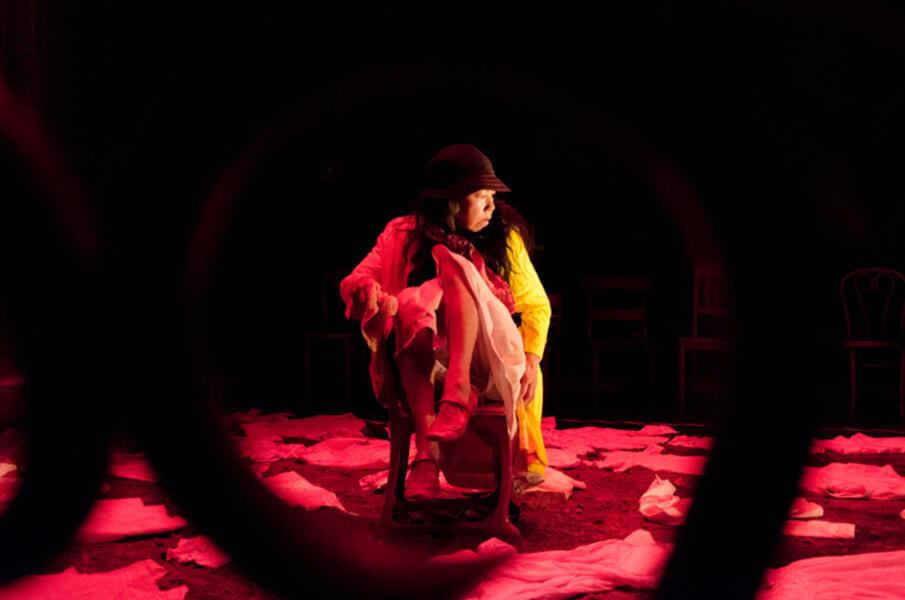 Dream Island (2015) @ Baltimore Theatre Project (MD), Joe's Movement Emporium (DC)"Be sure to not blink when Naoko Maeshiba is on the stage. Her Noh honed movements tie bold and brash with subtle and genuine and won’t let go. Her face is a living mask like that espoused by Jerzy Grotowski. She melds and shapes raw emotion into every eye flick, finger turn, and heel lift." - Theatre Bloom
Dream Island (2015) @ Baltimore Theatre Project (MD), Joe's Movement Emporium (DC)"Be sure to not blink when Naoko Maeshiba is on the stage. Her Noh honed movements tie bold and brash with subtle and genuine and won’t let go. Her face is a living mask like that espoused by Jerzy Grotowski. She melds and shapes raw emotion into every eye flick, finger turn, and heel lift." - Theatre Bloom -
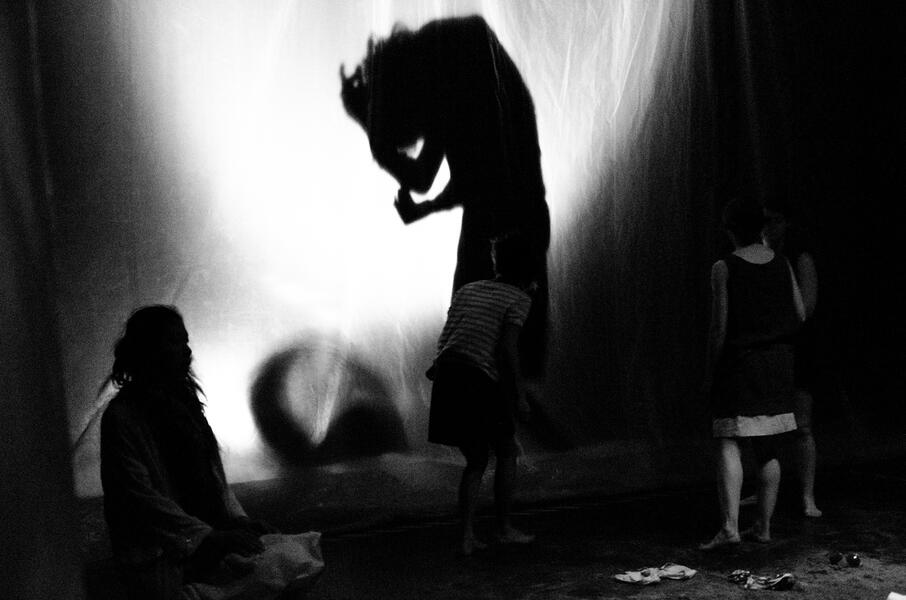 Dream Island (2015) @ Baltimore Theatre Project (MD), Joe's Movement Emporium (DC)The dialogue between the shadow and the light through different materials give me a rich pallet of language to work with. The translucent nature of this plastic made it possible to have a wide range of gradations and visibility. "This hypnotic and jarring performance, invites you to shatter your vision of what performance ought to be." - Theatre Bloom "Without consistently coherent dialogue or a clear action-driven plot, the sensory experience alone grounds the performance in a powerful but subtle narrative... Watching the performance unfold is like watching an action painter begin to construct an image before going over it or erasing over and over again, leaving remnants of what came before." -Baltimore City Paper, "From tropical dreamscape to trash dump to nuclear dystopia to plastic tsunami, the scene evolves as a surreal and at times absurdist painting of a real place that feels like a microcosm for the real world" - Baltimore City Paper
Dream Island (2015) @ Baltimore Theatre Project (MD), Joe's Movement Emporium (DC)The dialogue between the shadow and the light through different materials give me a rich pallet of language to work with. The translucent nature of this plastic made it possible to have a wide range of gradations and visibility. "This hypnotic and jarring performance, invites you to shatter your vision of what performance ought to be." - Theatre Bloom "Without consistently coherent dialogue or a clear action-driven plot, the sensory experience alone grounds the performance in a powerful but subtle narrative... Watching the performance unfold is like watching an action painter begin to construct an image before going over it or erasing over and over again, leaving remnants of what came before." -Baltimore City Paper, "From tropical dreamscape to trash dump to nuclear dystopia to plastic tsunami, the scene evolves as a surreal and at times absurdist painting of a real place that feels like a microcosm for the real world" - Baltimore City Paper -
 Dream Island (2015) @ Baltimore Theatre Project (MD), Joe's Movement Emporium (DC)We used the cinematic techniques such as 'cut', 'cross-fade', 'framing', and 'focal shift' in order to make the scene break blurry. This device gave the audience freedom to create and edit their own versions of "Dream Island" as they went along. "...an obsessional park where dreams are shredded and collaged together in a papier-mãchè sculpture of light, movement, and sound." - Theatre Bloom
Dream Island (2015) @ Baltimore Theatre Project (MD), Joe's Movement Emporium (DC)We used the cinematic techniques such as 'cut', 'cross-fade', 'framing', and 'focal shift' in order to make the scene break blurry. This device gave the audience freedom to create and edit their own versions of "Dream Island" as they went along. "...an obsessional park where dreams are shredded and collaged together in a papier-mãchè sculpture of light, movement, and sound." - Theatre Bloom -
Dream Island (2015) - Premiere @ Baltimore Theatre Project (MD), Tour @ Joe's Movement Emporium, DC - concept/direction/choreography/environment, object, and costume design/performancePart carnival, part laboratory, part archeological trip, “Dream Island” is inspired by a Japanese theme park built on a buried landfill called Yumenoshima. This piece digs, examines, and reveals ancient layers of debris by combining movement, text, music, and installation into humorous and dark absurdity. The audience is asked to bare witness as five characters attempt to search, reconstruct, and uncover memories and histories, both tangible and fleeting, personal and collective. "Dream Island" was 85-minute of length, consisting of three parts with thirteen vignettes.




